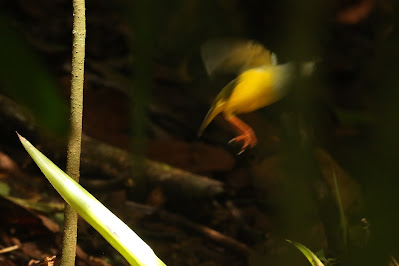 |
| White-collared Manakin getting to grips with a rainforest seed or fruit. |
All of the photos in this blog post are of a male bird. Within the family as a whole, which contains some fifty species, the males are the showy ones with a dazzling range of colours - yellows, reds, blues, oranges and more. Females are generally more subdued, with a palette of dull greens and browns. As a result, identifying female manakins of different species can be tricky. Such a colour discepancy between the sexes (the technical term is sexual dichromatism) provides a hint aboout their respective life strategies: males display to attact females and mate, but do very little else, while it is the females that make the nest, incubate the eggs and feed the young. No comment!
Mind you, the males put a lot of effort into enticing a mate. The White-collared Manakin has a neat courtship dance which we were able to observe easily at Tirimbina biological reserve (website link here) because the male concerned was displaying next to the main entrance path. His stage was an area of forest floor, which he had partially cleared, dotted with a number of conspicuous vertical stems. Perching on a low branch, he made a loud buzzing sound followed by dramatic pops or snaps like the sound of a breaking twig. These are produced by vibrating the wings; making mechanical noises in addition to their vocalisations is a key manakin trait. (Have a look at this video showing the extraordinary display and sound of Ecuador's Club-winged Manakin, for example.)
Every now and again our male would fly sideways to sit at the base of another stem and repeat the process, sometimes zipping back and forth rapidly between perches. The following two pictures were an attempt to capture some manakin movement.
 |
| White-collared Manakin - ready for launch |
 |
| White-collared Manakin - airborne |
(Apologies for the quality of the second image. The light was poor and the bird moved fast.)
We watched entranced, as the busy male buzzed from side to side. It wasn't obvious whether his efforts were being appreciated, although we had seen a female earlier nearby - an olive-green bird with vibrant orange legs - so her presence may have prompted the show. But the females can sometimes be hard to spot during the courtship process until they make their selection.
The White-collared Manakin's dance is spectacular, and worthy of being filmed - something that didn't occur to me at the time (but we had more birds to find of course!). However, there are a number of examples available online - such as this short YouTube video by Arnon Dattner from another forest reserve in Costa Rica. Enjoy, with the sound on.
I have watched manakins displaying in other Neotropical forests, including the closely-related White-bearded Manakin at the Asa Wright reserve on Trinidad. In that case, a number of manakins had gathered at the lek site, although they weren't particularly mobile. ("Lek" is a name given to both the place where males come to display and the displaying process itself.) But at Tirimbina, our White-collared Manakin male seemed to have the stage to himself. I'm hoping that his efforts weren't in vain.
Right - just three birds to go. What will be in the top three? And which bird merits the number one spot?



No comments:
Post a Comment